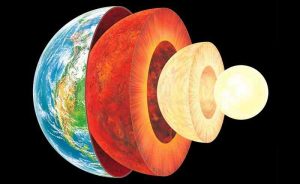
Experiments conducted at extreme conditions are giving scientists new insights into the chemical make-up of the Earth’s core.
Advanced laboratory techniques reveal that our planet’s metal centre — more than 1,800 miles below the surface — also contains silicon, an element commonly found in stony meteorites.
The findings support an existing theory that suggests Earth’s formation around 4.5 billion years ago was driven by extensive interactions between stony and iron-rich meteorites inside a cloud of dust and gas. This huge cloud of material also formed the Sun.
The chemical composition of the Earth’s core is still poorly understood, despite more than 60 years of research, scientists say.
Previous studies had suggested the core is composed of an alloy of iron and nickel, though other elements are thought to be present.
A team led by experts from the University of Edinburgh made the discovery by inserting tiny mixtures of iron, nickel and silicon into a device known as a diamond anvil cell. It can recreate the extreme pressures and temperatures present deep inside planets.
By squeezing the mixture together, they were able to achieve the same density as that found at the Earth’s core. The scientists predict that the temperature at the planet’s centre exceeds 5500 degrees Celsius.
The experiments were conducted at the Deutsches Elektronen-Synchrotron, Germany, and the European Synchrotron Radiation Facility in France.
The study, published in the journal Earth and Planetary Science Letters, received funding from the European Research Council. The work also involved researchers from the University of Bayreuth, Germany, and Hiroshima and Osaka Universities in Japan.
Dr Tetsuya Komabayashi, of the University of Edinburgh’s School of GeoSciences, who led the study, said: “The nature of the Earth’s core is the key to understanding a number of processes operating inside the planet. Our findings are an important step towards understanding how the planet was formed and how it may evolve in the future.”
Reference:
Tetsuya Komabayashi, Giacomo Pesce, Ryosuke Sinmyo, Takaaki Kawazoe, Helene Breton, Yuta Shimoyama, Konstantin Glazyrin, Zuzana Konôpková, Mohamed Mezouar. Phase relations in the system Fe–Ni–Si to 200 GPa and 3900 K and implications for Earth’s core. Earth and Planetary Science Letters, 2019; 512: 83 DOI: 10.1016/j.epsl.2019.01.056
Note: The above post is reprinted from materials provided by University of Edinburgh.










